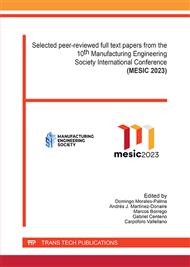p.140
p.147
p.155
p.167
p.176
p.184
p.194
p.204
p.213
Determination of Cost-Effective Machining Strategies for Rough Pocket Milling of Aluminum by Computer-Aided Manufacturing
Abstract:
Pocketing is one of the most important operations in the machining of complex parts. This milling process usually consumes a large part of the total machining time, especially if an extensive quantity of material is involved, determining the efficiency of the process. This paper studies the influence of the machining strategy and cutting conditions, and the geometry of the pocket on the machining time and cost when milling AW2007 aluminum alloy. For that purpose, a combined methodology based on experimental tests and CAM simulation is proposed. Cost analysis, which represents the main novelty of the research, takes into consideration, properly, the cutting time required to complete the pocket, the tool life, the tool change time and some economic factors such as power and tool costs. Spiral, curvilinear, parallel and zig-zag machining paths, along with seven different pocket geometries, are considered. Parallel and curvilinear milling trajectories have been found as the most cost-effective strategies. The efficiency of the parallel strategy increases with respect to the others as the geometry of the pocket becomes less compact, i.e., it is defined with a higher shape factor. According to the experimental tests and cost results, the machining operation should be performed with the highest feed rate, axial depth and cutting speed of the experimented values, 0.2 mm/tooth, 10 mm and 200 mm/min, respectively.
Info:
Periodical:
Pages:
176-183
Citation:
Online since:
October 2023
Keywords:
Price:
Сopyright:
© 2023 Trans Tech Publications Ltd. All Rights Reserved
Share:
Citation:



